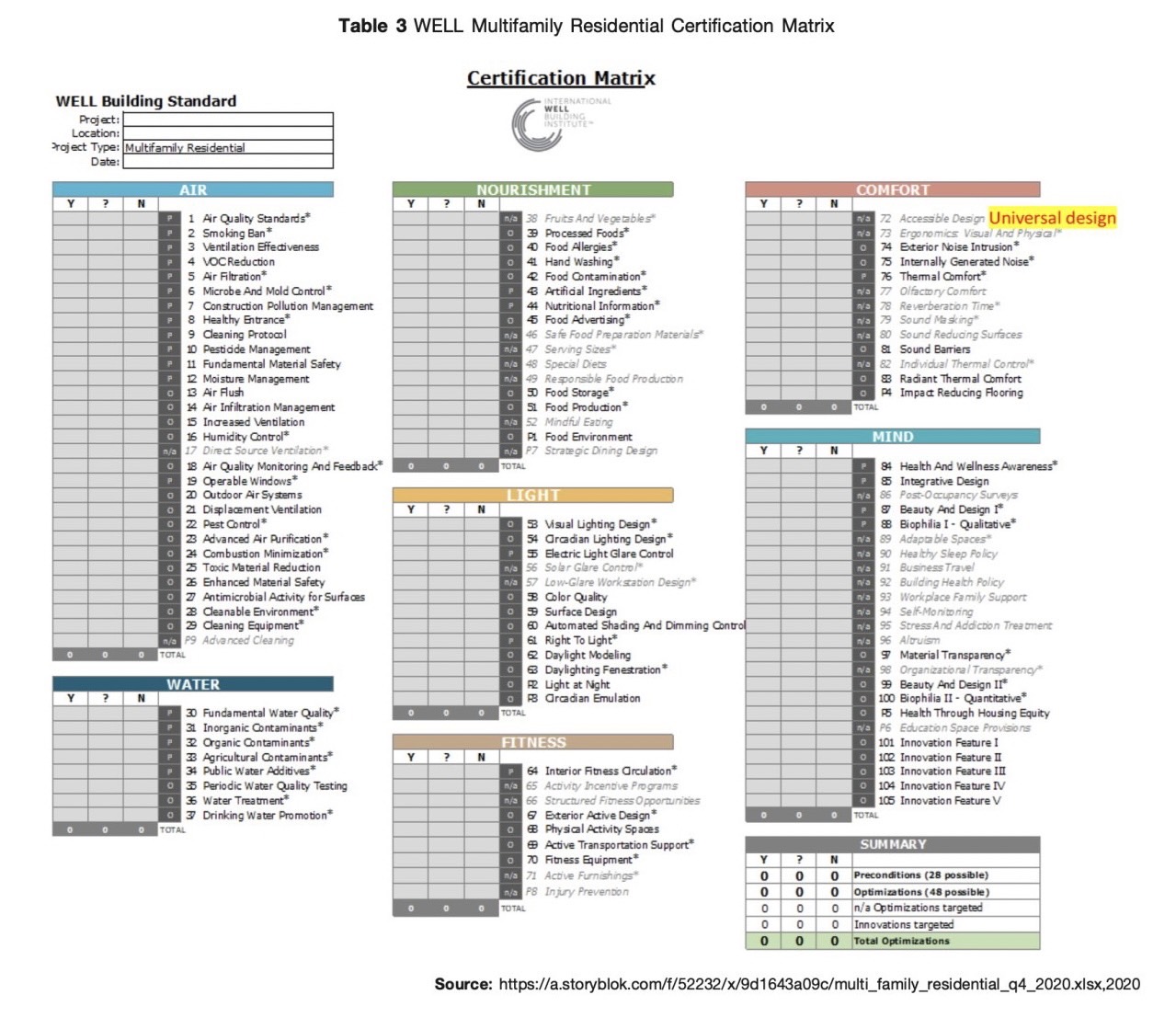Guidelines for Healthy Housing Development for All
Main Article Content
Abstract
Good health and well-being are some of the most significant trends in the contemporary world. Because of the coronavirus (COVID-19) pandemic, Thai people have healthier lifestyles, more concerned about their health, and consequently, change their behaviours to adapt to the ‘new normal’ ways of living. According to the result of an opinion survey by Suan Dusit Poll, 45.39% have changed their attention to healthcare by exercising, eating more healthy products, and emphasising housing and health education, and criteria for evaluating residential buildings have been established.
The research study shows that the assessment criteria such as LEED and BREEAM mainly focus on energy and resource efficiency to reduce environmental impacts. At the same time, WELL and CASBEE tools are primarily occupant-oriented and include universal design principles. All of these aim for improving residents’ quality of life. The analysis of factors for healthy housing development indicates that residents were satisfied with eight essential factors such as location, lighting, materials, water quality, comfort, sound, air quality and energy conservation. Among these aspects, comfort and sound are the most critical factors. The results highlight the emphasis of project developers and architects. In the context of Thailand, the SOOK Building Standard by Thai Green Building Institute (TGBI) is a criterion used to evaluate both residential and other types of buildings. The objective of this research is to produce building evaluation criteria for residential and other building types. Consequently, future studies are recommended to study the physical characteristics and satisfaction of residents within a project with a healthy home concept., particularly in the projects that have received a certificate of building assessment criteria.
Downloads
Article Details

This work is licensed under a Creative Commons Attribution-NonCommercial-NoDerivatives 4.0 International License.
All material is licensed under the terms of the Creative Commons Attribution 4.0 International (CC-BY-NC-ND 4.0) License, unless otherwise stated. As such, authors are free to share, copy, and redistribute the material in any medium or format. The authors must give appropriate credit, provide a link to the license, and indicate if changes were made. The authors may do so in any reasonable manner, but not in any way that suggests the licensor endorses you or your use. The authors may not use the material for commercial purposes. If the authors remix, transform, or build upon the material, they may not distribute the modified material, unless permission is obtained from JARS. Final, accepted versions of the paper may be posted on third party repositories, provided appropriate acknowledgement to the original source is clearly noted.
References
Akaramanee, N. (2018). Opportunities and limitations in the application of well-being concept in the development of condominium in Bangkok area. [Master’s thesis], Department of Housing, Chulalongkorn University.
Allen, J. G. & Spengler J. D. (2019). Homes for Health: 36 expert tips to make your home a healthier home. Healthy Buildings. https://homes.forhealth.org/wp-content/uploads/sites/9/2019/05/ Harvard_Healthy_Buildings_Program_Homes_for_Health_May-2019.pdf
American International Assurance. (2018). AIA reveals research Thailand faces a problem. “Financial disparities”. In the face of serious diseases. https://iserviceuat.aia.co.th/th/about-aia/media-centre/press-releases/2561/
AIA_RESEARCH_REVEALS_THAILAND_FACING_CRITICAL_ILLNESS_FINANCING_ GAP.html
Boonnom, S. (2021). Healthy condominium development guidelines case study of Jinn Well Being County, Pathum Thani Province and Knightsbridge the Ocean Sriracha, Chonburi Province. [Master’s thesis], Department of Housing, Chulalongkorn University.
Kramer, A., Lassar, T., Federman, M., & Hammerschmidt, S. (2014). Building for Wellness: The business case. Urban Land Institute.
National Health Commission Office. (2007). National Health Act, A.D. 2007. Retrieved August 30, 2020, from https://www.dms.go.th/
Paijitpithak, W. (2021). Opportunities and limitations to developing the horizontal property under the concept of well-being: A case study of Jirung Residences and Nusa Chevani Pattaya. [Master’s thesis], Department of Housing, Chulalongkorn University.
RISC Well-Being. (2021, June 30). Well-being materials. Facebook. https://www.facebook.com/risc wellbeing/posts/2744087232521109/
Singh, S. (2012). New mega trends. Palgrave Macmillan.
Strategy and Planning Division, Office of the Permanent Secretary, Ministry of Public Health. (2017). Health at a glance Thailand 2017. https://bps.moph.go.th/
Suan Dusit University. (2020). Suandusitpoll: New normal of Thai people from the Covid-19 situation. https://suandusitpoll.dusit.ac.th/
Thai Green Building Institute. (2020). The SOOK building standard. Retrieved May 17, 2021, from http://lgc.tgbi.or.th/
Thailand Development Research Institute. (2019). Longevity society: Thailand at a crossroad. https://tdri.or.th/en/2019/05/longevity-society-thailand-at-a-crossroad/
Thunyaporn, S. (2017). Koēt nǭi tǣ yū nān hēt hæng sang kom sūngwai [Born little, but staying long. The cause of “aging society”]. https://www.researchgate.net/figure/Life-Expectancy-of-Thai-Populations_fig1_366967905
Thuwawong, P. (2017). Development of design guidelines to promote well-being for sustainable residential buildings in Thailand. [Master’s thesis], Department of Housing, Chulalongkorn University.
Unprommee, S. (2013). Pattanākān samkan khǭng kān sāng soem sukkhaphāp : Rāingān kān prachum radap lōk rư̄ag kān sāng soem sukkhaphāp [Milestones in Health Promotion: Statements from Global Conferences]. Ministry of Public Health.
Wasi, P. (2007). Holistic health. Mehealth Promotion. https://mehealthpromotion.com/upload/


